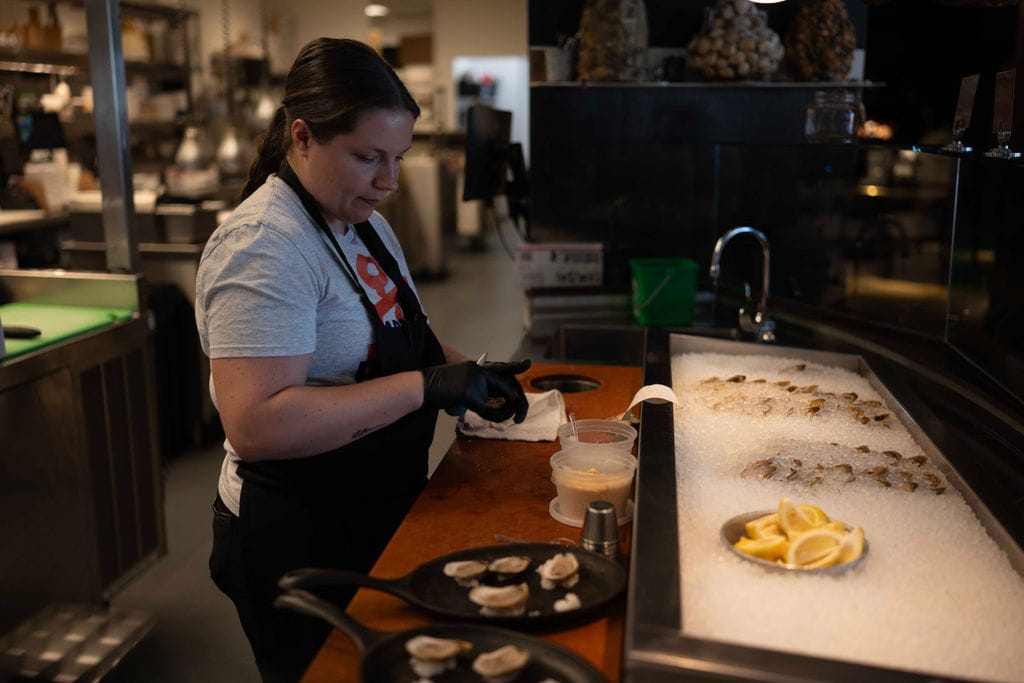Chefs draw inspiration from high quality, seasonal ingredients and transform them into extraordinary dishes. After tasting and perfecting the techniques a collection of those dishes become a menu. That menu is the backbone of a restaurant concept. But a menu full of delicious food is not enough.
When you open a new restaurant, you learn to juggle. You've got to nail so many details to get open, stay open, and make a profit. How does anyone succeed in this challenging industry? What do aspiring chefs and restaurateurs need to know?
One of the keys to success is building a strong restaurant brand. The pre-opening menu is just the beginning of your restaurant's brand. Here are five key factors that will help you build a better brand and help you stand out in a saturated market.
1. Tell a brand story
Everyone loves a good story. Whether your restaurant menu tells the story of your heritage or your passion for farming and foraging, your restaurant needs a good brand story. The story you create will inscribe a sense of place, drive interior design choices, and help focus your menu design.
Here are some questions to consider when crafting your brand story:
- Describe the past experiences that brought you to the moment of wanting to open this restaurant.
- What is your specialty dish and how is it made?
- What sets you apart from the other restaurants similar to yours?
- How will your guests feel when they come to your restaurant?
- What will guests tell others after eating at your restaurant?
- Is the restaurant part of your heritage, family story, or passion for an ingredient, region, style of cooking or service?
From new guests to local media to loyal customers, everyone should know the journey and feel the authenticity in the restaurant's brand. Brand recognition helps set expectations for the guest experience. It also gives you an opportunity to exceed them and create a path toward success.

2. Create a consistent design and vibe
Restaurant design and vibe are key components of the dining experience. Increasing prices make for a choosier customer base—potential customers will pay a premium, but only if they're getting a truly excellent customer experience. It's no longer enough for the food and drinks to be great. From the restaurant's visual identity to the pace of dining to the restaurant website, everything has to be dialed in.
The most important rule for nailing the physical design of your restaurant is consistency. Think about your overall brand and how that can translate to your physical space. The space and layout should be an extension of your narrative and influence the lighting, sounds, and spacing of tables or openness of the kitchen.
Oyster bars in seafood restaurants are a classic example of when design meets concept to drive additional revenue. Intentionally building the bar in the front of the restaurant make a powerful first impression on new customers. The glistening ice beds and fresh oysters are not only inviting, but make you thirsty for cold beverages. Beer, wine, and cocktails are high profit menu items which only compound with more oyster sales. Not to mention, nobody has ever been full after a dozen oysters for $48.
Fortunately, you don't need elaborate decorations or expensive, perishable ingredients. Photographs, memorabilia, and food displays are inexpensive extensions of your restaurant's brand. Using these elements in the interiors and on your website will help tell your story and make your restaurant brand come alive for new customers.

3. Appeal to the conscious consumer
Supporting local and sustainable business isn't a trend. If you want your restaurant brand to grow and succeed, you must keep seasonality, sourcing, and community top of mind. It's not only important for building a better restaurant brand. It will drive profitability and durability over time.
Prepare for fluctuations in market pricing and create a menu that’s flexible to swings in pricing or consumer demands. Without these safety nets, your restaurant's brand could be at risk.
Younger generations are more passionate about saving the environment and the effects that humans have on the earth. Their moral compass orients towards brands that care too. Even if you’re serving a basic menu, “local” feels good and it supports your community. "Community" can sound like a buzzword. But in reality, it's your regulars, your neighbors, and the people who have supported your business from day one. Give to their fundraisers, donate to school events, and engrain your brand into the local community. It does good for your customer base, and it feels good, too.
Creating partnerships with other local vendors is another great way to appeal to the conscious consumer. Showcase their ingredients on your menu or display their artwork on the walls. List the farmers or food and beverage vendors on your website and tell their story too. Visit these places and post videos and photos on your social media platforms. Developing deeper relationships with your purveyors and local artisans will drive awareness to your brand and strengthen the role you play in the local network.
4. Stand out in the digital world
In a sea of restaurants, standing out is critical, especially online. Between reservation platforms, delivery apps and social media, it can be overwhelming for customers to decide where to have dinner. Your online presence and how you're discovered is critical to your early and ongoing success. Make sure that your website has undergone search engine optimization. Use specific keywords on your restaurant website and Google Business Profile to show up in searches like “best sandwich near me” or “open late night."
Online ordering platforms help drive revenue for your business, but they're also tools to reach new customers online. Review sites are a great place to connect with first time customers and frequent visitors. Make sure to respond to all reviews, which means both negative and positive comments. Use a professional brand voice to respond to reviews. Remember that it's business, and try not to take it too personally when customers don't resonate with the food you serve or the dining experience. It may just be that they're not your target audience.
Repeat comments can be great for menu engineering or knowing which dishes to emphasize on your menu. You can make customer satisfaction an important part of your business by routinely requesting feedback on social media, through email marketing, on your website, and via your servers.
It’s easy to drown in the seemingly endless amount of social media content. Being as creative and consistent as possible provides a life raft. Posting food and beverage pictures on Instagram and Facebook help build your reputation as a great restaurant brand. But that's just one of many aspects of your social media presence. Tell stories about your staff and how they are contributing to your success. This humanizes your brand in the eyes of your restaurant's customers and can help with staff retention and recruitment during periods of turnover.
There’s no doubt the restaurant industry is a crowded space. Be consistent, keep your restaurant online presence up-to-date, and maintain positive relationships (with your guests, staff, and vendors) both online and in-person.

5. Be approachable, be familiar
Ever go to a restaurant or cocktail bar and the menu is filled with ingredients you don’t know or can’t pronounce? Cue the "foodie" imposter syndrome. The cool kids may think they know it all, but they don’t. And, nor should they know every single Amaro from Northern Italy. Being creative and original is especially important in big cities, but go too far and you might just be too “out there.”
Building a great restaurant brand means being approachable and using familiar ingredients. Don’t overwhelm your guests with too many unknowns or force your service staff to explain every single dish and ingredient on the menu. It slows down service and can make customers uncomfortable and unlikely to return. Make your menu approachable, engage with your guests, and guide them through the menu to make them feel welcome. Great restaurant brands don’t reinvent the wheel—they make awesome food and drinks and take care of people.
We were sure that our idea to open a Regional American cuisine restaurant in San Francisco’s Mission District was a hit. It was a restaurant brand by two guys who had traveled extensively across the United States, dined in many restaurants along the way, and became well versed in the story of American cuisine. Our emphasis on using seasonal and local ingredients, based on food traditions in different parts of the country was both original for our neighborhood and familiar to diners from far off destinations. Our Southern Fried Chicken came from locally raised chickens, the collard greens were grown less than 50 miles away, and grits were ground fresh and shipped from South Carolina weekly. Not only did it impart special flavors in the plated dish, but our brand grew stronger because people could identify with our concept and tell all of their friends about us.
Your Next Best Brand
No one can guarantee that your restaurant will be a smash hit. There will always be factors outside of your control. In an uncontrollable world, however, you can still control your restaurant branding. Focus on your story, engage with your guests, create approachable menus, and support your local community—success will be waiting for you.
When it seems like an impossible task, remember: the next best brand is you. Behind every successful restaurant are passionate restaurant owners. Sharing the work that goes into your business, the "why" behind your menu design, brand logo, and concept is the most important part.














